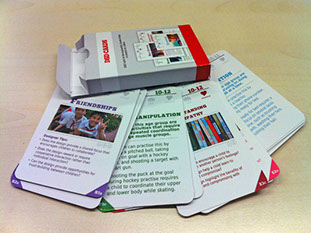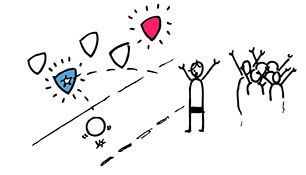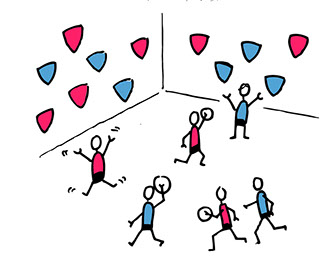Module - 2013
Interaction Design & Children
Introduction
In this module I worked in a team with two other students to develop a game for a gym class in primary school, while learning about the development of children in specific ages. We did this by creating personas and game concepts, based on theoretical knowledge about development of children in specific age groups and specific domains of development.
I chose this module mainly because I wanted some theoretical knowledge about designing for/with children before I start my FMP next semester. My FMP is going to be focused on the educational structures of primary or secondary schools, although I need a more specific focus in time. Although I wanted to learn techniques in how we can use children in our design process (which I did as well), I also came to realize my knowledge of children and their development over the ages was actually quite limited. Therefore I am very glad I did this module, because it feels like an essential first step towards my FMP.
Development of children and using the DSD cards
At the start of the module I was quite skeptical about generalizing children in their age as if age is the best thing they have in common. However I learned that, if you look at the development of children in the cognitive, physical, social and emotional domain, the children of the same age can indeed differ somewhat in their development phase, but the order of the development phases is almost always the same per child.
We did a first preliminary guess about what we found typical of children in specific age groups and I realized I was quite limited in my knowledge of this. I soon learned that the Developmentally Situated Design card deck we received in the module was a very handy tool to get a better picture of what a child is capable of in a specific age. For me, it works best to think of an example of an ability, activity, interest, environment or product that a child have and then use the cards to make this age appropriate. I also learned that it is then very easy to switch between age groups as well.
During the module I learned much more about the development in age groups of children and how we should implement this knowledge into our design. This knowledge and the cards will help me in my future projects with children, by preventing easy mistakes we can make when designing for children concerning the age appropriateness. It will also allow me to understand the children better and therefore it can also be an inspiration for new designs.
Expert meetings
Through the expert meetings with the two gym teachers I came to know that gym classes are in fact focused on the development in all four domains. I wander whether this is the case in other type of classes of primary school as well. My perception of classes was that those were only focused on one task that the children need to learn, while I see so much opportunity in combining the domains. This is something I want to investigate when I start my FMP.
These meetings also provided me with some proof that the DSD cards are indeed accurate, since the gym teachers each addressed very similar aspects that are on the cards as well.
Personas
Although I had some experience in making personas, I had never created them based on theoretical knowledge. I learned this could be very helpful and inspiring. A persona is both to validate and proof your concept, but can also inspire for a new aspect in your design concept. When presenting for a client, a persona that is based on theoretical knowledge of relevant aspects of your target group can provide a much more convincing story when referred to the source of this knowledge. Also, when using the persona in the further development of your concept, the new aspects that will pop up will probably work out as you intended.
Co-creation with children
During a reading assignment of a number of scientific papers I also learned some interesting and usable techniques to actively involve children in the design phase of my project. I learned some benefits and downfalls of these techniques, but I also learned there are probably many factors that are hard to control but still influence the result. The hardest part is that if you want children to take the role of the “designer” in a co-creation session, you to take into account that the ability of abstract thinking, which you need to imagine multiple outcomes and phases in your design, is not very developed yet. I learned you need to guide the children through a natural way through the different steps of the co-design session or let them play it out while recording the result. Although I will need some practice, I can already use the methods I learned through this reading assignment in my FMP.
Evaluation
The evaluation of you concept with your users can be done in many ways, but when your users are children it is more challengeable still. I learned some simple methods to persuade children to give extensive and qualitative input for your evaluation. A very inspiring method I found was the “Mission to Mars” method in which you persuade children to explain your concept to an alien, who doesn’t know how we do thinks as humans. This gives children the opportunity to answer the questions of the evaluation in much more detail. In my own practice with setting up an evaluation setting for our game concept I contacted my mother to review this, since she is a primary school teacher. It turned out that still many questions needed to be adapted towards a better “language of the children”, while I already explicitly had focused to use words and structure so younger children would understand the question. I noticed we adults are used to ask questions in an objective point of view, while you can better ask children something from a subjective point of view. Don’t ask as if the answer could be a fact, ask about “What do you think…” .
Discussion
This week I experienced that when designing for the age group of 10-12 I have the need to divine subgroups based on the quality of specific skills or interests. The older children get, the more different their skills in quality are being developed compared to each other. Therefore I believe you can say you design for the age of 5-6 rather then saying you design for 10-12, because then you need to be more specific on what skills and abilities they should have developed already. This was still a matter of discussion during the module, so it is an interesting topic to keep in mind when designing for children again.

Using the DSD cards


Developing concepts from theoretical background